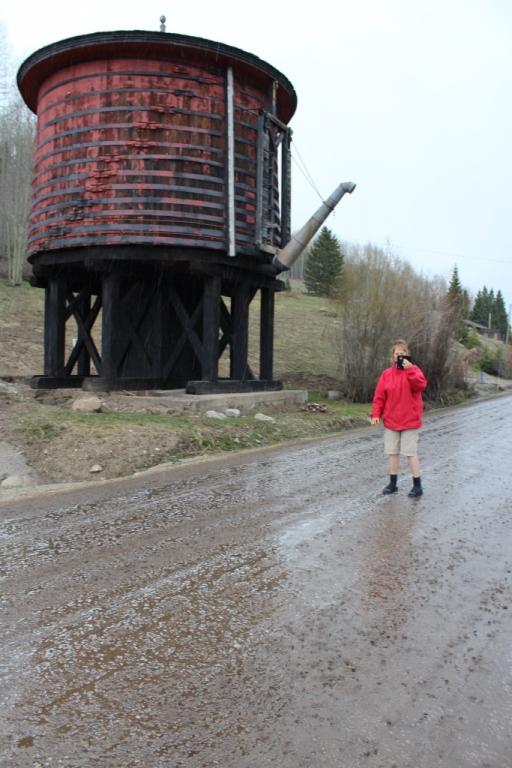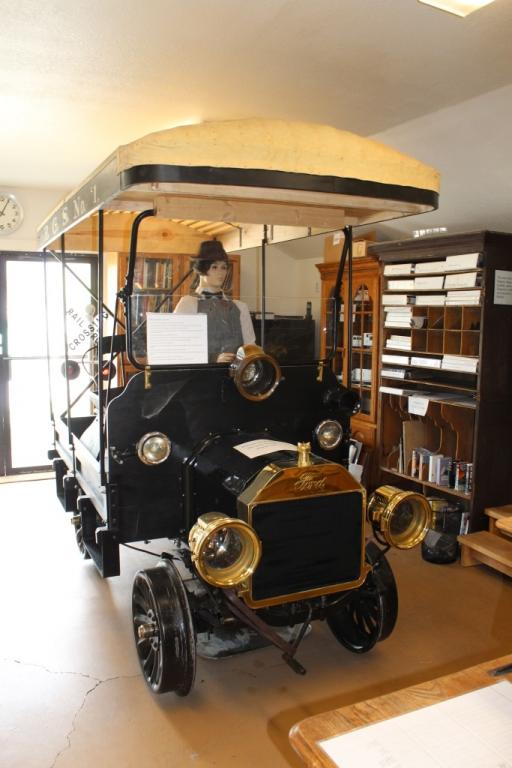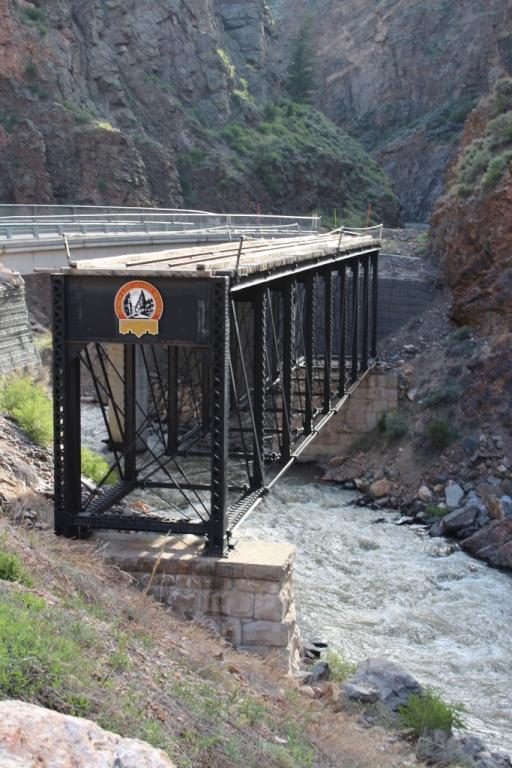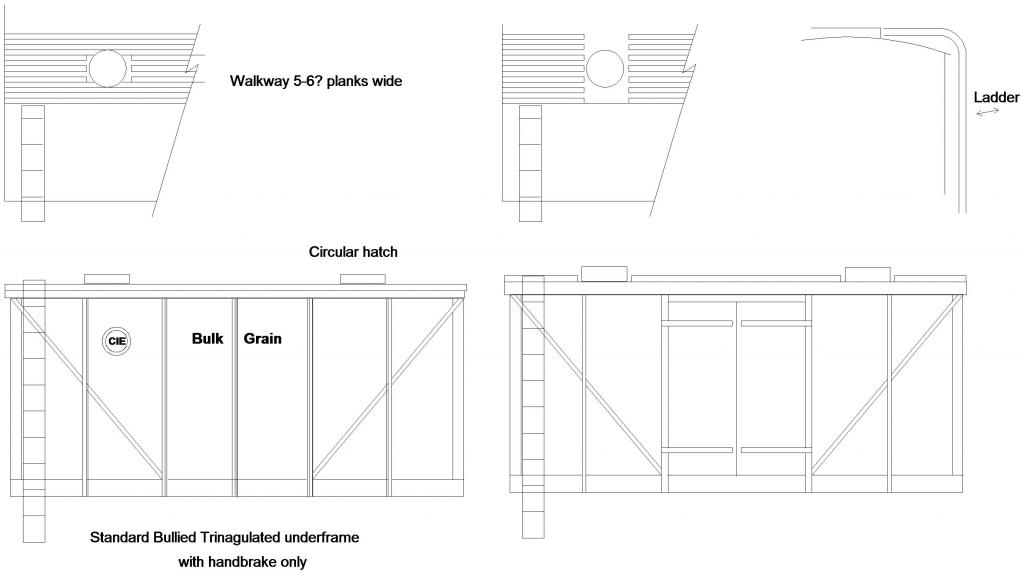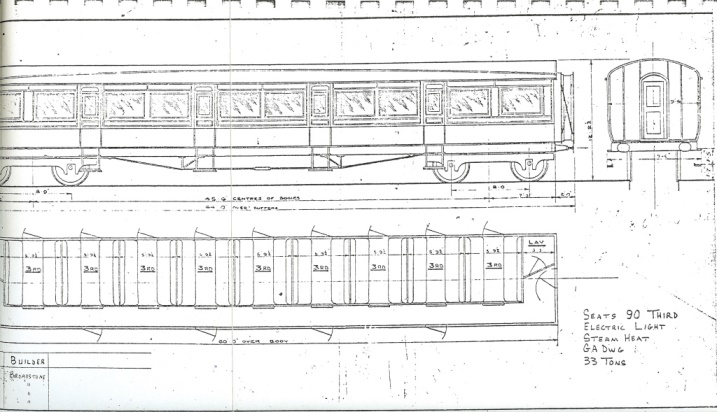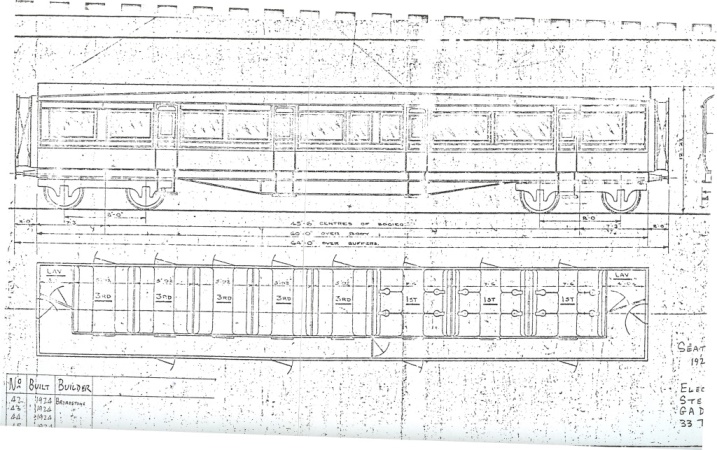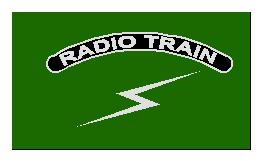-
Posts
4,879 -
Joined
-
Last visited
-
Days Won
119
Content Type
Profiles
Forums
Events
Gallery
Everything posted by Mayner
-
Dun Laoire was basically a hub for mail traffic from London & the Midlands to the United States, Southern & Western Ireland, with mail trains running through to Cobh and Galway with connecting services from the Cork and Galway main lines to other provincial centres. Through passenger trains ceased to run between Dunlaoire Cork and Galway when the connection to Carlisle Pier was disconnected in connection with the DART electrification works in the early 80s. NIR later extended some of the Enterprise services through to Dun Laoire to connect with the "Mail Boat" but could not compete with the frequent low cost air services between the UK and Northern Ireland
-

Narrow Gauge in the Rockies Tin Geese & snow in May
Mayner replied to Mayner's topic in Photos & Videos of the Prototype
Traces of the mines, depot and trestles have disappeared from the Ophir area though sections of trackbed are in use as forestry access roads. http://www.ridgwayrailroadmuseum.org/photos.html The once remote Trout Lake water tank appears to have been one of the signature photo spots on the RGS. Trout Lake Water Tower We ran into a thunder storm between the water tank and the trestle but unfortunately no ghostly apparition of a Galloping Goose or a hard working steam loco on a stock or ore train. Trout Lake Trestle Luckily the snow was not heavy though we missed out on a photo of the mountains at Lizard Head pass, our next stop was at the replica depot and RGS Motor Car #5 at Dolores (pop 925) Dolores Depot & Galloping Goose #5 Dolores was once an important depot on the RGS the terminus for trains operating on the northern section of the railroad to Ridgeway, the depot was demolished and yards transformed into US Highway 145 The replica depot and demonstration track was constructed by a local historical society in the early 1990s and the Goose restored in 1998 and has since operated on the Durango & Silverton & Cumbres and Toltec railroads. Goose 5 represents the final evolution of its type, rebuilt with a war surplus GMC engine & Wayne bus body and the van section converted for tourist operation after the railroad lost the mail contract. Durango "In Durango, In Durango The Spaniards did fandango, In Durango, Where the sun goes down at Noon" D&SRR train waiting to leave town before noon May 27/16 The RGS used the DRGWR depot, yard and roundhouse at Durnago. Durango always was and still is a railroad town although Durango & Silverton tourist trains run northwards to Silverton, the main line eastwards over Cumbres to Alamosa (the last steam operated main line in the USA)and the branch to Farmington NM closed in the late 1960s The passenger depot and yard give the impression of big time railroading although the freight yards at the east end of town have disappeared under road development -

Narrow Gauge in the Rockies Tin Geese & snow in May
Mayner replied to Mayner's topic in Photos & Videos of the Prototype
In some ways the highlight of the trip the journey from Montrose to Durango with a side trip to Cortez & Mesa Verde took in the remains of the Rio Grande Southern in south west Colorado. The RGS which connected with the DRGWR at Ridgeway (True Grit) and Durango abandoned in the early 1950s served a rugged and remote part of South West Colorado using mainly cast off DRGWR equipment, & like the Donegal pioneered the use of internal combustion railcars for passenger and mail traffic. Its said that the 162 mile RGS was built because of the impossibility of completing a direct line over the mountains between Silverton & Ridgeway. Despite its early closure a surprising of RGS artifacts survive to this day. RGS 2-8-0 #74 at Colorado Railroad Museum The largest of the RGS 2-8-0s ex-Colorado & Southern #74 purchased by the RGS from a Denver scrap dealer in 1948! Replica Ford inspection railcar Ridgeway Replica RGS Motor 31 Ridgeway Railway Museum The community at Ridgeway (pop 924) have established a railway museum which includes a short demonstration track for RGS1, full size and models of freight and passenger rolling stock, the museum and tourist information centre is operated 100% by volunteers, restoration and models to a very high standard. View of San Juan Mountains from Dallas Divide The Divide was the 1st major summit crossed by the RGS out of Ridgeway the Silverton terminus of the DRGWR is on the opposite side of the mountains. Although the day started out clear snow started falling as we dropped down to the San Miguel River and cleared off as we approached the former mining town now fashionable ski resort of Telluride (To hell you ride). Telluride Depot Possibly sole surviving standard RGS house style depot with freight shed. The depot may have been re-sited closer to the river, to make way for apartments and units. Bridal Veil Fall at head of canyon Telluride is in a box canyon, the line extended a mile or so to Pandoro Mill where silver and metal ores were brought down by arial tramways and later roads from the top of the canyon, a bit steep and windy for a hired car. Back on the road again, snow at Trout Lake May 26 16 The RGS was most famous for its long and high trestles on the climb out of the San Miguel river valley around the Ophir Loop to Lizard Head Pass. The majority of the high trestles had collapsed and Ophir disappeared under road improvements but the folks at Ridgeway said that trestle and water tower at Trout Lake were still standing -
Try CPS http://cspmodels.com/abante/index.php?rt=product/category&path=65 or High Level Kits http://www.highlevelkits.co.uk/they may be able to supply a suitable funnel for the Guinness Loco.
-

Narrow Gauge in the Rockies Tin Geese & snow in May
Mayner replied to Mayner's topic in Photos & Videos of the Prototype
After the Georgetown Loop a drive across the South Park to see the remains of the Colorado & Southern narrow gauge lines(Denver South Park and Pacific) on to Montrose & San Juan Country to ride the Durango & Silverton & Cumbres & Toltec lines before returning to Denver. Georgetown Shay & GE diesel at Silver Plume depot & museum closed to public on day. C&S mogul on display Beckenridge (LGB Mogul!) This loco was restored to service for one season on the Georgetown Loop, but withdrawn & put on public display as a result of mechanical problems Como Depot & Hotel One time hub of the South Park system, more or less became a ghost town when the system finally closed in the late 1930s. Como roundhouse and township The roundhouse was designated a "National Historic Monument" meaning the owner is expected to preserve the building at their own expense. Trestle original DRGWR main line Black Canyon Newly re-painted DRGWR 278 C16 2-8-0 at Cinnamon National Parks Service depot 278 was placed on display on the trestle at Cinnamon when the original DRGWR narrow gauge main line through Black Canyon closed in the late 1940s. I am not sure if the National Park Service plan to re-mount the loco on the trestle or display the loco at Cinnamon. The original 3' gauge Denver and Rio Grande main line followed a round about route from Denver to Grand Junction via Pueblo and Montrose where it linked up with the Rio Grande Western. The main line was shortened in two stages and standard gauged bye passing Montrose and later Pueblo to form todays Union Pacific main line from Denver through the Moffat Tunnel and Glenwood Springs to Salt lake City -
Starting out from Denver on Monday basically a whistle stop tour of Colorado narrow gauge lines & museums starting with the Colorado Railroad Museum in Golden and working westwards. Colorado Railroad Museum Rio Grande Southern railmotor Galloping Goose #2 7 Like the County Donegal the RGS turned to i.c. railcars to cut operating costs in the 1930s. The majority of the railmotors have survived, replicas have been built of scrapped Geese. Replica RGS railmotor #1 at Ridgeway Colorado Prototype for the Bachmann On30 & Large scale models. RGS Goose #2 and Denver Leadville & Gunnison (Union Pacific) 2-8-0 191 The DLGR started life as the Denver South Park and Pacific, never made it to the Pacific and was beaten in its race with the Rio Grande to reach the mining boom town of Leadville and the Utah border. GE 50T diesel on the Georgetown Loop Railroad The Georgetown Loop Railroad is a re-construction of a section of line closed and dismantled in the late 1930s featuring the Devils Gate Bridge where the line looped back on itself through 180° to gain height. The railroad was restored by a local historical society, the US Navy assistance in re-building the high bridge. The GE 50T would have made a mighty useful loco on the Donegal if it survived into the 60s
-
Final photos in ND on Friday before heading west to Colorado CP 5038 on rail train Fairmount Rail threading machine Wide vision caboose on rail train Late evening RRVWR local completing switching RRVWR local leaving town Local ha added a cut of open hopper cars from the elevator track to its train in addition to empty grain and loaded flour hoppers from the mill.
-
Friday Way Freights very few through freights around today watched a CP & RRVWR way freights on the SOO Line. East bound CP way freight on the Main Line awaiting departure from Hankinson Through freights appear to set out and pick up at the small yard in Hankinson with a local serving local industries and yards. Making up the train was time consuming as each move involved blocking a grade crossing. Westbound RRVWR way freight between Oswald and Hankinson Eastbound CP way freight takes the Rosholt line at Veblen Junction This move caught me by surprise I had expected to see the two trains crossing at Oswald was delayed by roadworks and did not realise that an Eastbound could run direct to the Rosholt line without reversing. The Rosholt line serves a large elevator complex and an ethanol plant hence the mixture of hopper and tank cars. The return trip from Rosholt approaching ND HW 11 These Eco series locos appear to have replaced ex Milwaukee bandit GP 38-2 & CP SD40-2 on the local trains. RRVWR GP20-C 4400 preparing to switch Fairmount flour mill The loco consist has uncoupled from their train in order to make a pick up of empty grain and laden flour cars from the mill while the switch crew confer. There is a change in plan a cut of open hopper cars from the Fairmount Elevator track is added to the train before switching the mill.
-
DMVWR 7505 & 7510 picked up 105 grain cars off the CP Hankinson interchange Mon morning. The CP had split the train into approximately 4 sections to avoid blocking grade crossings. The locos arrived light from Oakes, the crew re-combined the train completed the brake test and were away in about 15 minutes. The ex-SOO line to Oakes and the ND State capital has more of a roller coaster gradient profile compared to the main line from ST Paul to the Canadian border at Portal the 7000hp of a pair of SD45s comes in useful. 7505 & 7507 West of Hankinson Geneseo Junction Geneseo is the Junction for a former BN branch to Aberdeen South Dakota that sees occasional use by DMVWR Although the line to Oakes and Bismark is operated as a short line by the DMVWR Canadian Pacific retain ownership of the track and roadbed The SOO Line & Great Northern once operated approx 40 miles of parallel trackage between Aberdeen Line MI & Geneseo ND. The RRVWR enjoys running rights over the Canadian Pacific as a result of a 1950s agreement allowing the GNR to abandon its line between the two places. Look no FRED! Just a red flag no flashing end of train telemetry device or FRED. Rather than following the train to Oakes, I headed across the border into South Dakota to check out the Sunflour Railroad a shortline that operated a portion of a CP branch line the Fairmount & Veblen. I had stumbled across the Sunflouer in 2004 when the line appeared to have ceased regular operation, although there was a rumour that the owner would fly up specially from Texas to fire up and drive the lines SW1 to move traffic for a customer. New Effington Oil tank cars at a grain elevator? The Sunflours main business appears to be storing out of service oil tank cars as a result of the cut back in US oil production. Victor SD 2016 good use for hopper cars that keep derailing The elevators/storage hoppers have become more decrepit, the SW1 no longer stored in the open surrounded by sunflours. The railroad have constructed a workshop and added some spur tracks to for mow equipment clear of the running line and siding south of the elevator complex. Do it yourself elevator
-
Interesting find Mr Bracken. Frank was an old friend and talented modeller who modelled the GWR/WR in EM and was deeply involved in the MRSI Loughrea layout. I helped Frank as a roadie moving, setting up an operating Frank's Wentworth and Louhrea at various exhibitions. I wonder did Frank take the actual photos although he modelled the GWR/WR he sometimes spoke of building an Irish layout.
-
The DMVWR SD45s have their original 20 cylinder power units with their distinctive singing sound, the DMVWR locos were a must as I had missed seeing the MRL locos in 2004. A bit more short line variety with the Otter Tail Railroad at Fergus Falls Minesota which serves a number of grain elevators and a coal fired power station using 4 axle EMD power. OTVR 1483 ex NKP GP9 introduced 1959 at Fergus Falls OTVR4016 ex NW GP40 The Otter Tail Valley is owned and operated by Gensesee and Wyoming that owns operates freight railways in Australia, North America and Europe including Freightliner in the UK. OTVR Yard Fergus Falls Fergus Falls would make an interesting switching layout with two small yards and a number of rail served industries including grain elevators and feed mills. Fergus Falls was once served by the Great Northern and Northern Pacific and although both lines were closed to through traffic, most of the rail infrastructure in the city is intact including two depots and yards and rail served industries including grain elevators and feed mills. RRVWR 2194 GP38-2 tied up at Beckenridge MI The RRVW has an interesting loco fleet including some Caterpillar powered GP20-C rebuilds of CBQRR GP20 locos that included parts from traded in FT units dating from the early 1940s.
-
The absence of lineside fencing and grade crossings makes it fairly easy to get close to the action without actually trespassing. Railroad workers are reasonably tolerant towards rail fans, the concern is primarily security and delay to traffic as a trespasser would be on a hiding to nothing tying sue a railroad. Canadian Pacific snow plow at Hankinson Today I went in search of EMD SD45 diesel locomotives on the Dakota Missouri Valley & Western (DMVWR) a regional that operates over 360 miles of former SOO Line trackage and connects with the CP main line at Hankinson ND. The DMVWR started out with a motley collection of leased EMD GP jeeps and more recently graduated to using 6 axle power including a trio of ex Winsconsin Central SD45s to handle heavy grain trains over an undulating road. DMVWR 3132&3149ex CN SD40-3 & 7505&7510 SD45 at Oakes ND No trains were scheduled out of Oakes today but the crew fired up 7505 & 7510 to switch cars from a soy bean plant to interchange with the RRVWR Oakes is an important originating point for grain train operation for both the RRVWR & DMVWR and exchange point between the two railroads. Switching complete back in the barn until Monday morning's trip to Hankinson (50 miles) RRVWR Hankinson turn at Fairmount The RRVWR operates on trackage rights westwards over the CP from Aberdeen Line Junction serving industries at Fairmount & Hankinson. The RRVWR switches the flour mill in the background which receives grain and dispatches flour. Tank cars likely to be from industries in Hankinson
-
South of Aberdeen Line Junction the BNSF line a consist of locomotives await as a grain train is loaded Straight out of the box BNSF 4248 introduced Feb 2016 NRX (ex BNSF) 7211 SD40-2 switches cars during loading at the elevator. The yellow structure is part of the fall restraint system for working on top of the hopper cars Elevator storage tracks laden grain cars on left empties on right, loading shovel used to move cars between storage roads and elevator, while loco positions cars for loading at elevator The train has to be divided into sections and switching is complicated by grade crossings at either end of the elevator and across the storage tracks. A sign of changing times oil tank cars stored out of use on a short line Storing out of use cars can be a useful source of income for shortlines and regionals
-
More of the same over the border in Minnesota, with regionals and short lines adding a bit of variety. CP 9771 AC44CW heading Autoracks & Intermodal just east of Tenney MI 5/11/2016 The CP (SOO) line across western Minnesota & North Dakota is un-signalled (Dark Territory) controlled by Track Warrant Control (TWC) a updated version of the classical American Train Order system (verbal instruction by radio from dispatcher to locomotive engineer). The line is currently being converted to CTC. Early European explorers and settlers considered the prairie as a treeless wilderness rather than the fertile land that supported the Souix and later the wheat lands of the United States and Canada A few miles east near Campbell BNSF 7529 ES44DC awaits a clearance with an East Bound way freight The train consist is mainly made up of grain cars and tank cars from the Red River Valley & Western (RRVW) a regional that operates over 500 miles of ex-Burlington Northern branch lines out of Beckenridge MI. RRVWR CF7road slugs at Beckenridge. The CF7s were re-builds of streamlined F units into road switchers by the ATSF The RRVWR road fleet was out for the day leaving the CF7s outside the Beckenridge. Surprise UP 5452 AC45CCTE on the CP line leading an eastbound grain train across the BNSF diamond at Aberdeen Line Junction MI I narrowly missed a jackpot with two trains approaching the diamond as an eastbound BNSF train just cleared the junction as I arrived. A CP MOW crew were carrying out maintenance work on the diamond between trains
-
CP 8763 GE ES44AC leads westbound manifest through Fairmount North Dakota 5/10/16 My first train photo in the United States after 12 years after setting out 04:00 Sunday morning for fights Auckland-Brisbane, Brisbane-Los Angeles. Los Angeles-Minneapolis on family holiday for father in law's 90th with some railfanning in the Mid-West & Colorado.
-
Nice work David, it looks like I will have to build Erne or Blackwater & a brake van to go with the two Branchlines CVR coaches I assembled about 25 years ago
-

Changes to our Hornby 2016 range.
Mayner replied to steventrain's topic in British Outline Modelling
The underlying problem may be market saturation in the British RTR market as opposed to exchange rates. Hornby still seems to be geared to high volume production while Heljan and "the comissioners' appear to have carved out a niche market for high value low volume run models. -
Seems to be some updates to the Mike Morant collection. Mainly steam with some early diesel interlopers
-
Body sides and overlays & tailboard fold from two pieces of brass. Support the fret on a solid surface while bending up the sides. Check that the sides are bent to 90° with an engineers square before bending up the head board. The overlays are fixed in place with superglue. I used a cocktail stick to place a thin layer of glue on the overlays before folding down into position on the sides and tail board. Fix the subframe to the body using the slots in the floor for alignment The body can be bolted to the chassis with the bolts used to attach the flatbed body. All ready to deliver a load of agricultural lime to a farm or a load of sugar beet to the railhead.
-
The fret The parts are designed to fold to shape with the engraved fold lines on the inside of the bend. The tipper sub frames fold up into a U shape its best to clamp the section to be folded in a vice. Modifications to Base Toys Leyland Comet Chassis. The overhang at the rear of the flat bed chassis needs to be reduced for a tipper. Cut back with a junior hacksaw or a razor saw and tidy up the cut edge with a needle file.
-
The CIE built grain wagons appear to have been built in two batches 23901-23950 12t 16'11" over headstocks built 1955 & 25021-250140 converted from H vans. The wagon nearest the camera in the photo of Polloxfen's mill in "Rails to the West" does not have side doors, the next pair of wagons have side doors. The GNR bulk cement wagons were similar in design to the H van and BR vans of the period though the body was in steel and the shape of the hopper visible. I remember reading somewhere that the doors on the H van conversions were welded shut. The sidings at Ranks Mill Clara were set up for unloading grain from hopper wagons. The roof detail is taken from a photo of wagons in the Dardanelles sidings of the Point Yard the slatted walkways appear to be 3X2 battens on bearers. MGWR 1924 Comp MGWR 1924 3rd The 1924 coaches were supposed to be the most comfortable 3rd Class coaches on the GSR, I haven't seen a decent photo of the corridor side, the compartment coaches appear to have had similar continuous footboards to the GSWR stock. It just might be doable to kitbash one our of a Farish OO Corridor coach with microstrip to represent the panel beading. The Midland did not build matching bogie brakes although some new 6 wheel brakes complete with oil lamps were built around the same time possibly to replace stock damaged in the Civil War
-
The Railway Procurement Agency (RPA) is probably as confused itself, the RPA was separated from CIE supposedly because of Government lack of confidence in the companys ability to deliver the LUAS on time and within budget and the small matter of negotiating a new labour agreement with a 10 year no strike clause & excluding the more militant CIE unions The original Metro North proposal morphed out of CIEs original proposal for a cross city LUAS line from Stillorgan to Ballymun. The northern section of the line was 1st put on hold to minimise traffic disruption during the construction of the Port Tunnel, then morphed into a "metro" to overcome objections to street running through the city centre. The 2005 Metro proposal was basically LUAS underground rather than heavy rail.
-
Driver seems to be a Balkan war veteran suffering from PTSD, I don't think the muppets who abandoned a transit van on a level crossing outside Kilkenny about 10 years ago were ever brought to justice. Going back to GPS at work we had an electronic route planner that would direct you to turn off a flyover onto a railway line or road below if there was no slip road or junction.
-
Probably more to do with management thinking from the Dick Fearn era that running excursion trains (and freight) was outside IEs core business of running scheduled Intercity and Commuter trains rather than an actual lack of demand. The Executive Train was an integral part of IEs operations in the early 90s and was regularly chartered by clients such as Guinness and IT companies for entertaining guests & visits to manufacturing plants. It will be interesting to see if IE or a private operator is willing to test the market to establish if there is demand for something between an Intercity and Belmond level of service.5 Perhaps a 4-5 coach MK4 set or an Intercity Railcar set refitted to a high standard accommodating a maximum of 100 passengers with a kitchen car and meals prepared by a celebrity chef 200Eu all in for a days outing to Killarney, Connemara, Armagh or The Giants Causeway
-
There is a 19773 photo of a B181 hauled Radio Train on the North Dublin Loop Line in David Murray's "Rails Around Dublin" (Iain Allen Publishing) The loco is complete with Radio Train lightening bolt headboard, the train appears to be made up of "standard" CIE coaching stock of the era with a 4w luggage van and the 1935 Bredin dining car leading the consist, the next coach appears to be a 64 seat open. Its likely that older stock would have been used rather than Cravens in later days. Cravens would have been allocated to main-line and later Intercity links and in the 1960s had a reputation rougher running compared to older stock. The Killarney Radio trains appear to have been worked by 400 Class 4-6-0s in the early 50, there is a published photo of a Radio Train leaving Mallow for Killarney junction, possibly with an ex GSWR leading. In the early days coaches would have been a mixture of GSWR/GSR wooden bodies and Bredin corridor stock, the most important vehicle would have been the catering vehicles, a kitchen or restaurant car complete with kitchen and waiting staff would have been essential to cater to 2-300 people on one of these trains.
.png.c363cdf5c3fb7955cd92a55eb6dbbae0.png)


